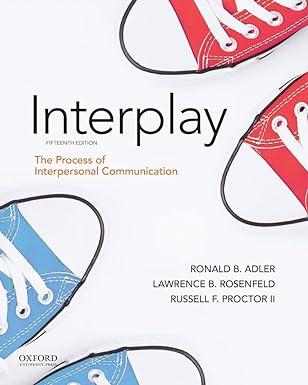Question
Read and respond with your thoughts to both response. 1. Response #1 Exposure therapy involves exposing an individual to the object, situation, place, or memory
Read and respond with your thoughts to both response.
1. Response #1
Exposure therapy involves exposing an individual to the object, situation, place, or memory that they fear. People tend to avoid what they are afraid of, which only intensifies their fear. Exposure therapy allows people to confront their fears in a safe environment and overcome the negative symptoms they experience. While exposure therapy may be uncomfortable at first, it can be beneficial in reducing avoidance and anxiety symptoms. A major benefit of exposure therapy is having milder reactions, by being expose to their fear gradually and repeatedly, the intensity of their reaction will likely decrease and become more manageable. Exposure therapy can sometimes entirely eliminate certain symptoms of fear and anxiety. Another benefit of exposure therapy is improvement of emotional regulation, as it aims to teach people how to interrupt their emotional response to their fear and regulate it both mentally and physically. Imaginal Exposure is a popular exposure therapy, during imaginal exposure, a person is asked to vividly imagine their fear. Under the guidance of their therapist, they will describe, in detail, the object, place, or situation they are afraid of. While doing this, they will be asked to take note of the emotions they feel so they can begin to process them. By processing their emotions, they can work toward reduced anxiety and fear. One of my students has social anxiety disorder where she fears a range of social situations like going to the movies. Exposure therapy for the fear of socializing can involve a hierarchy including these situations that cause her anxiety. This is one of the easier exposures to conduct because it is relatively straightforward to find and involves herself in the situations that she fears (therapist.com, 2023). Another behavior technique that would be very beneficial to my student would be practicing mindfulness, which is the practice of paying attention, noticing, and being present, no matter what she is doing. Developing mindfulness can help her observe her thoughts and feelings so she can better understand how to react to situations, especially social ones that may make her feel anxious. It can also help her maintain a good mindset for reaching out and connecting with others.
1. Response #2
The first behavioral technique that I will describe is relaxation techniques. There are a variety of methods that can be used to practice relaxation techniques (e.g. deep breathing, progressive muscle relaxation, visualization exercises). This technique is great for clients to use when they experience anxiety or issues with sleeping patterns. Another area these techniques are great for is overthinking or disconnecting from reality. A fictional character that could utilize this behavioral technique is Katniss from The Hunger Games. After experiencing the trauma of the games, she struggles with a lot of post-traumatic stress symptoms. Learning these kinds of skills would help Katniss bring herself back to reality when she has flashbacks, through the use of grounding techniques. Using deep breathing exercises would be beneficial in reducing anxiety after a nightmare and helping her go back to sleep. When teaching her the skills it would be beneficial to include guided breathing techniques (worksheet 1) and worksheets with information about different grounding techniques (worksheet 2). Especially with mindfulness, everyone will find something different that works best for them.
The second behavioral technique I am describing is exposure therapy. With this behavioral technique, it is meant to help people recover from their anxiety/phobias. There are a variety of ways that people can gain this exposure, such as through virtual reality, imagery, or real-life exposure. An example of a fictional character that would benefit from exposure therapy is Sheila, from Shameless. Sheila is a character that has Agoraphobia, leading to her locking herself in her home. Much of the exposure therapy technique that would be utilized is helping her build her confidence to leave her home. In the show, it is shown that she is receiving virtual reality exposure therapy where leaving her home is simulated to her. She would build from this treatment towards exposure therapy in reality.
Step by Step Solution
There are 3 Steps involved in it
Step: 1

Get Instant Access to Expert-Tailored Solutions
See step-by-step solutions with expert insights and AI powered tools for academic success
Step: 2

Step: 3

Ace Your Homework with AI
Get the answers you need in no time with our AI-driven, step-by-step assistance
Get Started


